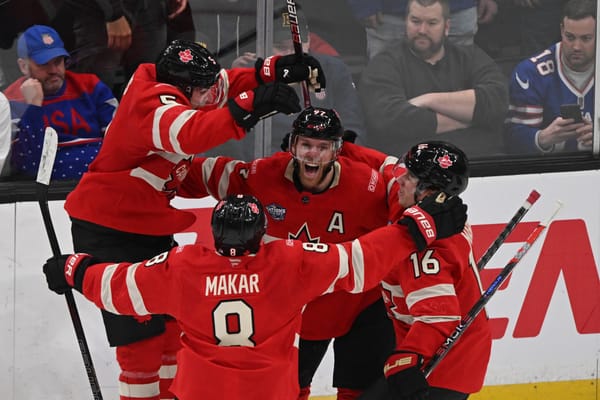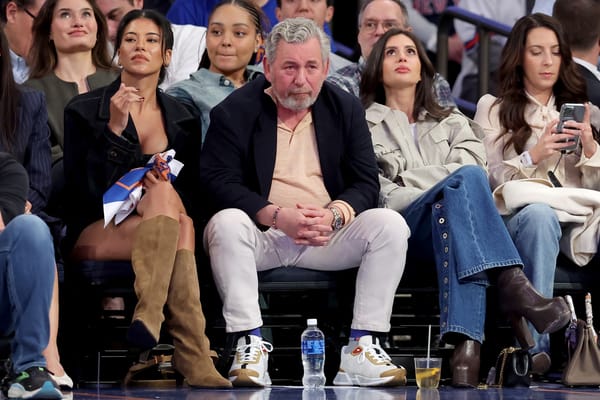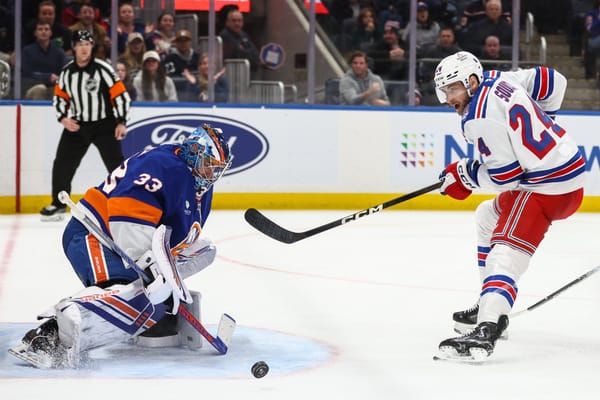No, Lundqvist Still Isn’t the Problem
Henrik Lundqvist has been the backbone of the New York Rangers for the majority of his career. Lundqvist is a generational talent, already ranking tenth all-time in career wins with 405. The Rangers have exceeded expectations and deep playoffs runs because of their netminder, regardless of the lackluster team in front of him.
The Rangers have a number of issues that must be addressed – none of which is their goaltending. For years, the team in front of him has not put up nearly as strong of a performance as he has, which has forced Lundqvist to carry his team.
The Rangers’ coaching does not adequately support their goaltender either. Alain Vigneault and his coaching staff should focus on building a team around Lundqvist, rather than utilizing defensive tactics that impede his game. Despite his coaching and team, Lundqvist has been sensational – but he cannot steal every game for the Rangers.
Lundqvist has given his heart and soul to this franchise, only to receive poor treatment from the media and the fans. The media constantly speculates how Lundqvist’s window is closing and discussing how he is past his prime. If Lundqvist falters at all, fans are quick to turn on him and look for his replacement. Both the media and fans frequently fault Lundqvist for the Rangers’ stumble before looking at the whole picture.
Without Lundqvist’s play, his team would not rank as high as they have in the regular season, nor would they have made it as far into the playoffs as they have in recent years. This season was no different, even though Lundqvist did not have his best regular season.
At 5v5, Lundqvist’s regular season save percentage this season was 0.918 – the lowest in years. Lundqvist’s play was ridiculed throughout the regular season, often without mention of the team bleeding shots in front of him. Through his 57 regular season appearances, Lundqvist faced 316 high danger shots, the fifth most of all 84 goaltenders that played at least 50 minutes at 5v5. His high-danger save percentage was 0.829
Lundqvist played behind a stumbling defense all season. The Rangers faced a high number of shot attempts, as exemplified by their Corsi against per 60 of 58, which was the eighth highest in the league during the regular season. Their shots against per 60 of 30.35 was not impressive. And the Rangers allowed the eighth most scoring chances against per 60 of 8.72.
The onus was on the coaches to improve the Rangers’ defense that consistently allowed a high frequency of shots on Lundqvist. The Rangers’ top pair of McDonagh and Girardi, who played 775.68 5v5 minutes together this season, saw 426 shots on goal against. Out of the 467 defensive pairs that played at least 50 minutes of 5v5 time in the regular season, the pair of McDonagh and Girardi ranked 449th in shots against. The Rangers’ second pair of Marc Staal and Nick Holden ranked ahead of McDonagh-Girardi with 352 shots against – which was the 436th worst in the league.
Unsurprisingly, the three defensive pairs that were intact for most of the regular season ranked high in scoring chances against as well. Of all defensive pairs in the league, McDonagh-Girardi faced the 16th highest number of scoring chances against, followed by the Rangers’ third pair of Brady Skjei and Kevin Klein, who were on the ice for 43 scoring chances against. The Rangers’ second pair of Holden and Staal did not fair much better, with 32 scoring chances against. All three of the Rangers’ primary defensive pairs ranked within the 50 worst in scoring chances against this season. With all of that in mind, does Lundqvist’s lesser season make more sense?
When the Rangers’ head coach Alain Vigneault noticed that Lundqvist was struggling, he held his star goaltender accountable rather than identifying the most detrimental aspect of their game: the defense.
As much as the Rangers rely on their goaltender, they set him up for failure and should not be surprised that he cannot win a Stanley Cup by himself – as it will always require a team effort. And Vigneault is no stranger to having a great goaltender, as he coached Roberto Luongo, who helped take his team to Game 7 of the 2011 Stanley Cup Final. By this point, Vigneault should have realized that a team has to consist of more than just a generational talent in net.
Had Vigneault made adjustments on defense to support his goaltender, maybe the Rangers would still be in the playoffs. However, the problem persisted all season and dragged into the playoffs. Vigneault’s coaching tactics only made the defensive issues even more glaring – putting more pressure on Lundqvist.
Lundqvist led the Rangers into the playoffs in the last seven consecutive seasons. Although Lundqvist may not have had his strongest regular season, he improved in the postseason. Lundqvist lives for the competitive environment of the playoffs, as he shown throughout his career, yet his competency for these playoffs was questioned.
Had it not been for Lundqvist, the Rangers would have faced a first round elimination to the Montreal Canadiens.
In the Rangers’ second round series against the Ottawa Senators, Lundqvist did slip at times – in part due to his lack of defensive support. The Rangers’ inability to play in a 6-on-5 situation proved costly and the coaches needed to be held accountable for their decisions, rather than Lundqvist, as their deployment in the final minutes cost them three games this postseason.
The Rangers allowed the highest number of shot attempts against in the post season (652) and their Corsi against per 60 of 63.06 was the fourth worst in the playoffs. The Rangers trailed only the Edmonton Oilers (324) in shots faced (316), which challenged Lundqvist throughout the playoffs.
Of the 40 defensive pairs that played at least 50 minutes of 5v5 in the postseason, the combination of McDonagh and Girardi were on the ice for the most shot attempts against (221). With McDonagh and Girardi in front of him, Lundqvist faced 100 shots against – which was the third highest number of shots against a defensive combination in the playoffs. Additionally, that pair faced the most scoring chances against than any other pair in the playoffs. And that was the pair that received the most ice time in the playoffs for the Rangers (198.62 minutes of 5v5).
The combination of Staal and Holden had the worst shots against per 60 (31.94) of the Rangers’ defensive combinations. But they were the pair that was deployed in front of Lundqvist in the most critical moments of a number of games, (remember Game 2 against Montreal? All of the Canadiens’ goals in regulation were scored with Holden and Staal on the ice, yet when the Rangers had a one-goal lead in the final minute, that pair was deployed – again showing how the coaching impeded on Lundqvist and the Rangers).
Of the shots Lundqvist faced, 156 were low-danger shots. He only allowed two low-danger goals in the playoffs, which resulted in a 0.987 low-danger save percentage. Additionally, Lundqvist faced 90 medium danger shots (the third most).
Even more concerning was the 70 high-danger shots Lundqvist saw in the Rangers’ 12 playoff games, which was the most of any goaltender (prior to the Oilers playing Game 7 in the semifinals. Through the Oilers first 12 playoff games, their goaltender Talbot faced 69 high-danger shots). However, Lundqvist was exceptional against high-danger shots. His stellar play earned him the second highest high-danger save percentage of the playoffs (0.871), trailing only Jake Allen of the St. Louis Blues (0.889).
Even with a dreadful defense playing in front of him, Lundqvist still was a game-changer. Were there games that Lundqvist could have been sharper? Yes. However, could his team have put him in less dire situations? Yes. Could his coaches have adjusted their defensive pairs, deployment, and tactics to better reinforce the play of their goaltender? Yes.
But in the games of these playoffs that the Rangers collapsed, like Game 2 against Montreal, and Games 2 and 5 against Ottawa, who was at fault? Lundqvist or the coaches? Could the defensive deployment have cost them any of those games? Could the Rangers’ defensemen somehow contribute to the Senators and Canadiens’ game tying goals against in any way? Is it at all possible that a goal being scored against is the fault of anyone other than the goaltender?
Lundqvist may be 35 years-old, but his career is far from over. He has proven every season and postseason that he is still capable of playing his high-caliber game. Henrik may be past his prime, but that does not mean his window is closed or that he cannot win a Stanley Cup. Even if Lundqvist’s play in the regular season drops, he has demonstrated his game rises with the intensity of the playoffs.
Furthermore, it always has and always will require a team effort to win the Stanley Cup. As the Rangers have proven every season, it is not sustainable to rely this heavily on a goaltender, even one as great as Lundqvist. There must be contributions from the forwards, defense, and coaching, as well as the goaltending.
Henrik has proven that he is the greatest difference-maker for the Rangers. Had Lundqvist had a more-complete team in front of him, the Rangers likely would have won by now – maybe in 2012 or 2014, when Lundqvist carried the Rangers to the Eastern Conference Final and Stanley Cup Final.
Lundqvist is the easiest scapegoat to blame, as he has the highest cap hit on the team (7 years/$8.5 million annual average value), but that does not mean that he should be. He is not responsible for the Rangers’ playoff elimination this season. Had it not been for Lundqvist carrying his team that often generated much less offense in their first round series, they would not have even met the Senators.
Wins in the Stanley Cup Playoffs are a team effort and so are the losses. It is about time that the management, fans, and the media recognize what they have in Lundqvist while they still can, since as it is so frequently said: Lundqvist’s window is closing.
*Data is at 5v5 and is sourced from Corsica.hockey.




